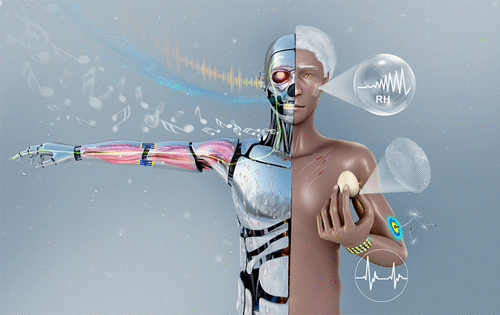当前位置:
X-MOL 学术
›
Acc. Chem. Res.
›
论文详情
Our official English website, www.x-mol.net, welcomes your
feedback! (Note: you will need to create a separate account there.)
Materials, Structures, and Functions for Flexible and Stretchable Biomimetic Sensors.
Accounts of Chemical Research ( IF 16.4 ) Pub Date : 2019-01-17 , DOI: 10.1021/acs.accounts.8b00497 Tie Li 1 , Yue Li 1 , Ting Zhang 1
Accounts of Chemical Research ( IF 16.4 ) Pub Date : 2019-01-17 , DOI: 10.1021/acs.accounts.8b00497 Tie Li 1 , Yue Li 1 , Ting Zhang 1
Affiliation

|
Currently, flexible and stretchable biomimetic sensing electronics have obtained a great deal of attention in various areas, such as human-machine interfaces, robotic smart skins, health care monitoring, and biointegrated devices. In contrast with the traditional rigid and fragile silicon-based electronics, flexible and stretchable sensing electronics can efficiently capture high-quality signals when integrated on curved surfaces due to their elastic and conformal characters, which are expected to play many important roles in the foreseeable age of intelligence. Its realization strongly relies on rapid advances in the development of high-performance and versatile flexible and stretchable sensors, and effective ways to achieve high performance are rational designs of the sensing materials and microstructural configurations. This Account showcases the recent progress in flexible and stretchable biomimetic sensors covering several critical aspects of materials, structures, and applications. Nature-inspired active matter and architectures, which have been well-tuned by evolution through millions of years of optimization, provide us the best learning choices to overcome the restrictions of current sensor techniques such as low sensitivity, instability, and delayed response time. Biomimetic sensing materials and microstructural patterns can efficiently acquire synthetic response abilities, endowing the new-type flexible sensors considered as "smart" electronic components on account of the counterparts to living organisms. Moreover, the developments of diverse functions and multifunctional applications become more and more important in the creation of novel flexible electronics beyond those existing technologies. For instance, flexible and stretchable sensors with the capability of mimicking various human behavioral patterns can be developed to boost the emergence of artificial robots, which can take the place of human beings in strenuous activities, enabling progress in social science, technology, and productivity to improve the quality of human life. For the above purpose, inspired by the in-depth understanding of working principles of living organisms how to operate their natural characteristics, sensing materials with stimuli response (light, humidity, mechanics, etc.) and multifunctionalities (superhydrophobicity, degradation, self-healing, etc.) provide distinctive and multiple detection features generally encountered in their traditional counterparts. In addition, artificial micro- to nanostructures derived from naturally existing high sensitivity structures (such as insect crack or leaves) and stretchable configurations (wrinkle, texture, mesostructures, etc.) offer additional feasible strategies for producing favorable sensitivity and stretchability. Flexible and stretchable biomimetic sensors with analogous senses to those of human beings (such as tactile and auditory senses) have attracted tremendous attention for their diverse applications for next generation smart electronics. The long-term progress of these novel sensors influencing the next generations of bioinspired intelligence systems and medical electronics are also envisioned.
中文翻译:

柔性和可拉伸仿生传感器的材料,结构和功能。
当前,柔性和可拉伸的仿生传感电子设备已在各个领域引起了广泛关注,例如人机界面,机器人智能皮肤,医疗保健监视和生物集成设备。与传统的刚性和易碎的硅基电子产品相比,柔性和可拉伸的传感电子产品由于其弹性和共形特性,在集成到曲面上时可以有效捕获高质量的信号,预计在可预见的时代将发挥许多重要作用智慧。它的实现在很大程度上依赖于高性能,多功能柔性和可拉伸传感器发展的快速进步,而实现高性能的有效途径是传感材料和微结构配置的合理设计。该帐户展示了柔性和可拉伸仿生传感器的最新进展,涵盖了材料,结构和应用的多个关键方面。经过数百万年的优化,经过进化优化的自然启发性活性物质和架构为我们提供了最佳的学习选择,以克服当前传感器技术的局限性,例如低灵敏度,不稳定和响应时间延迟。仿生感测材料和微结构模式可以有效地获得合成响应能力,从而使新型柔性传感器(由于与生物体相对应而被视为“智能”电子组件)成为可能。而且,在创建那些现有技术以外的新型柔性电子产品时,多样化功能和多功能应用程序的开发变得越来越重要。例如,可以开发具有模仿各种人类行为模式能力的柔性可伸缩传感器,以促进人造机器人的出现,这种人造机器人可以代替人类从事艰苦的活动,从而在社会科学,技术和生产力上取得进步。改善人类生活质量。出于上述目的,受到对生物体如何操作其自然特征的工作原理的深入了解,对具有刺激响应(光,湿度,力学等)和多功能(超疏水性,降解,自我修复)的材料的启发。 , ETC。)提供了与传统同类产品相比常见的独特且多种检测功能。另外,从天然存在的高灵敏度结构(如昆虫的裂缝或树叶)和可拉伸的构型(皱纹,质地,介观结构等)衍生出来的人造微纳米结构为产生良好的灵敏度和可拉伸性提供了其他可行的策略。具有类似于人类的感觉(例如触觉和听觉)的柔性可拉伸仿生传感器因其在下一代智能电子产品中的多种应用而引起了极大的关注。还可以预见,这些新颖的传感器将对下一代生物启发的智能系统和医疗电子设备产生长期影响。
更新日期:2019-01-17
中文翻译:

柔性和可拉伸仿生传感器的材料,结构和功能。
当前,柔性和可拉伸的仿生传感电子设备已在各个领域引起了广泛关注,例如人机界面,机器人智能皮肤,医疗保健监视和生物集成设备。与传统的刚性和易碎的硅基电子产品相比,柔性和可拉伸的传感电子产品由于其弹性和共形特性,在集成到曲面上时可以有效捕获高质量的信号,预计在可预见的时代将发挥许多重要作用智慧。它的实现在很大程度上依赖于高性能,多功能柔性和可拉伸传感器发展的快速进步,而实现高性能的有效途径是传感材料和微结构配置的合理设计。该帐户展示了柔性和可拉伸仿生传感器的最新进展,涵盖了材料,结构和应用的多个关键方面。经过数百万年的优化,经过进化优化的自然启发性活性物质和架构为我们提供了最佳的学习选择,以克服当前传感器技术的局限性,例如低灵敏度,不稳定和响应时间延迟。仿生感测材料和微结构模式可以有效地获得合成响应能力,从而使新型柔性传感器(由于与生物体相对应而被视为“智能”电子组件)成为可能。而且,在创建那些现有技术以外的新型柔性电子产品时,多样化功能和多功能应用程序的开发变得越来越重要。例如,可以开发具有模仿各种人类行为模式能力的柔性可伸缩传感器,以促进人造机器人的出现,这种人造机器人可以代替人类从事艰苦的活动,从而在社会科学,技术和生产力上取得进步。改善人类生活质量。出于上述目的,受到对生物体如何操作其自然特征的工作原理的深入了解,对具有刺激响应(光,湿度,力学等)和多功能(超疏水性,降解,自我修复)的材料的启发。 , ETC。)提供了与传统同类产品相比常见的独特且多种检测功能。另外,从天然存在的高灵敏度结构(如昆虫的裂缝或树叶)和可拉伸的构型(皱纹,质地,介观结构等)衍生出来的人造微纳米结构为产生良好的灵敏度和可拉伸性提供了其他可行的策略。具有类似于人类的感觉(例如触觉和听觉)的柔性可拉伸仿生传感器因其在下一代智能电子产品中的多种应用而引起了极大的关注。还可以预见,这些新颖的传感器将对下一代生物启发的智能系统和医疗电子设备产生长期影响。











































 京公网安备 11010802027423号
京公网安备 11010802027423号